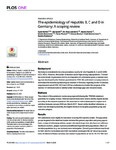The epidemiology of Hepatitis B, C and D in Germany: A scoping review
Steffen, Gyde
Sperle, Ida
Leendertz, Siv Aina
Sarma, Navina
Beermann, Sandra
Thamm, Roma
Bremer, Viviane
Zimmermann, Ruth
Dudareva, Sandra
Background
Germany is considered to be a low prevalence country for viral Hepatitis B, C and D (HBV, HCV, HDV). However, the burden of disease can be high among subpopulations. To meet the world Health Organization (WHO) viral hepatitis (VH) elimination goals, a national strategy was developed by the German government in 2016. We performed a scoping review to understand the baseline epidemiological situation in Germany regarding burden of disease, sequelae and care of HBV, HCV and HDV as a reference to monitor the progress of the national VH elimination and to identify further knowledge gaps and research needs.
Methods
The protocol of the systematic review was prepared following the PRISMA statement guidelines for scoping reviews. Relevant search terms were used to identify eligible studies according to the research questions. We searched six online databases for original work published between January 2005 and March 2017. Based on the identified references, a matrix was developed presenting the eligible literature by targeted population group and outcome category.
Results
104 publications were eligible for extraction covering 299 outcome results. The population groups targeted in the identified studies included the general population and proxy populations, a range of clinical populations, people who inject drugs, men who have sex with men, healthcare workers, people in prisons and different migrant/mobile populations. Other vulnerable populations (e.g. sex workers) were not targeted. Overall, good evidence was found for HBV and HCV prevalence and HBV vaccination coverage in the GP and proxy populations. Evidence for these outcomes was weaker in populations at risk for VH. For HBV and HCV incidence and mortality, we identified large evidence gaps in all population groups. Outcomes on VH sequelae and care were mainly covered by studies in clinical populations of people living with viral hepatitis. For HDV the overall evidence available was scarce.
Conclusions
We created a comprehensive evidence-based overview on the current epidemiological situation of viral hepatitis in Germany. We identified knowledge gaps for further research and established a baseline for future monitoring of viral hepatitis elimination goals in Germany.
Dateien zu dieser Publikation

